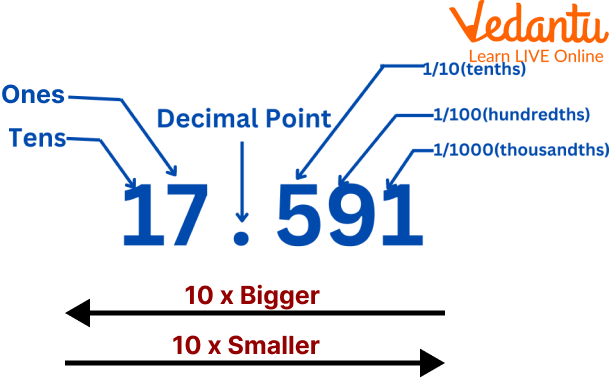




Introduction to 2 Decimal Places
Rounding to two decimal places is a common mathematics practice. By rounding the number off to the closest whole number, this procedure helps to make the calculation simpler. There are many uses of rounding off to two decimal places in math. Students should know how to round off numbers to two decimal places because rounding off numbers can help them get the correct answer in their calculations. They can use this technique for any number and any type of problem. This way, they will be able to understand how rounding works and how it is applied in different situations.
What is Round off?
Rounding a number means the process of making a number simpler such that its value remains close to what it was. The result obtained after rounding off a number is less accurate, but easier to use. While rounding a number, we consider the place value of digits in a number.
For Example: Round 0.439 to the nearest hundredths.
Ans: In this case, the digit to the right of the hundredths place, that is, the thousandths place is 9, which is more than 5. So, we will add 1 to the digit in the hundredths place, that is, 3 + 1 = 4, and write 0 in the digits to the right. So, 0.439 will be rounded to 0.44.
Rounding the Numbers up to 2 Decimal Places
In other words, if we are asked to round off a number to two decimal places, it means we need to round it to the nearest hundredths. Similarly, when we are asked to round off a number to one decimal place, it means we need to round it to the nearest tenths. Decimal numbers are often rounded off to make them easier to understand and use in calculations. Rounding a decimal number to two decimal places is the same as rounding it to the hundredths place, which is the second place to the right of the decimal point. For example, 2.83620364 can be rounded to two decimal places as 2.84, and 0.7035 can be rounded to two decimal places as 0.70.

Rounding off Decimals
Steps to Round Off to Two Decimal Places
Here mainly the decimal numbers have been told in this regard to the nearest hundredth or correct to two decimal places, which are like this.
Step 1: Identify the digit at the thousandths place or the third place to the right of the decimal point.
Step 2: If the thousandths place digit is greater than or equal to 5, the hundredths place digit will be increased by one. And if the thousandths place digit is less than 5, the hundredths place digit will remain unchanged.
Step 3: Ignore all the remaining digits in the decimal part of the number.

2 decimal places example
2 Decimal Places Example
Given are some 2 decimal places examples of rounding off, that explain how to round numbers to the proper second place of decimals, to the nearest hundredths:
Q 1. Round 0.9999 to two decimal places.
Ans: To round a decimal number to two decimal places, the first step is to identify the thousandths place digit which is 9 in the given number 0.9999. Since 9>5, we have to add 1 to the hundredths place digit. The digit at the hundredths place is 9, so if we add 1 to it we will get 10.
Again we have to add 1 to the tenths place keeping 0 at the hundredths place. The tenth place digit is 9, so 9 + 1 = 10.
So, again add 1 to the ones place digit keeping 0 at the tenths place. Finally, we get that 0.9999 ≈ 1.00. Therefore, by using the round to two decimal places rules, we get that 0.9999 ≈ 1.00.
Q 2 Round off, 36.978, correct up to two decimal places.
Ans: 36.978 → 36.98
When rounded to the closest hundredths, the result is more than the given decimal amount since we can see that the digit in the thousandth place is 8, which is more than 5. So, the decimal number is adjusted to 36.98.
Therefore, the result of rounding off, correct to two decimal places is 36.98.
Q 3 Round off, 7.755, correct up to two decimal places.
Ans: To round to two decimal places, we have to look at the digit at the thousandths place. The given number is 7.755. Here the thousandths place digit is 5. So, we will be adding 1 to the hundredths place digit for rounding up the value. After rounding up, the digit at the second decimal place will become 5+1, which is 6. Therefore, 7.755 ≈ 7.76.
Q 4. Evaluate square root of 3 upto 2 decimal places
Ans: The square root of a number can be calculated using the long division method.
Given:
Since
Practice Problems
Here are some practice problems of rounding off to two decimal places, which are as follows:
Q1. 8.514
Ans. 8.51
Q2. 89.937
Ans. 89.94
Q3. 461.631
Ans. 461.63
Q4. 4.839
Ans. 4.84
Q5. 37. 365
Ans. 37.37
Summary
Rounding to two decimal places is a common math practice. It is used to make calculations easier and more accurate. Rounding off is the most widely used practice in doing calculations. It’s used to make calculations easier and more accurate. This technique can be applied in many aspects of life, including finance, science, and engineering. In this section, we briefly discussed the concept of rounding off to two decimal places. We will also discuss how rounding affects computation and some of the practice problems, based on rounding off to two decimal places in math.
FAQs on Correct to Two Decimal Places
1. How can we round to three decimal places in math?
When we round numbers to the nearest thousand or we can say to the three decimal places, we check the digit in the hundreds place. If the digit in the hundreds place is 5 or more than 5, we increase the thousands place by 1 and write 0 in all the digits to the right. In case, if the digit in the hundreds place is less than 5, we write 0 in the hundreds place and in all the places to its right, while the digit in the thousands place remains as it is.
2. Where do we use rounding of numbers in real life?
In real life, we usually round numbers whenever the exact value is not so important. For example, if we want to know the approximate amount that we spent in a grocery store, or the amount while estimating a budget, or while expressing larger figures like the population of a town.
3. What are the two common rounding-off mistakes?
Common rounding-off mistakes are:
Rounding off the decimal point in a number.
Rounding up or down a number by more than one digit.











